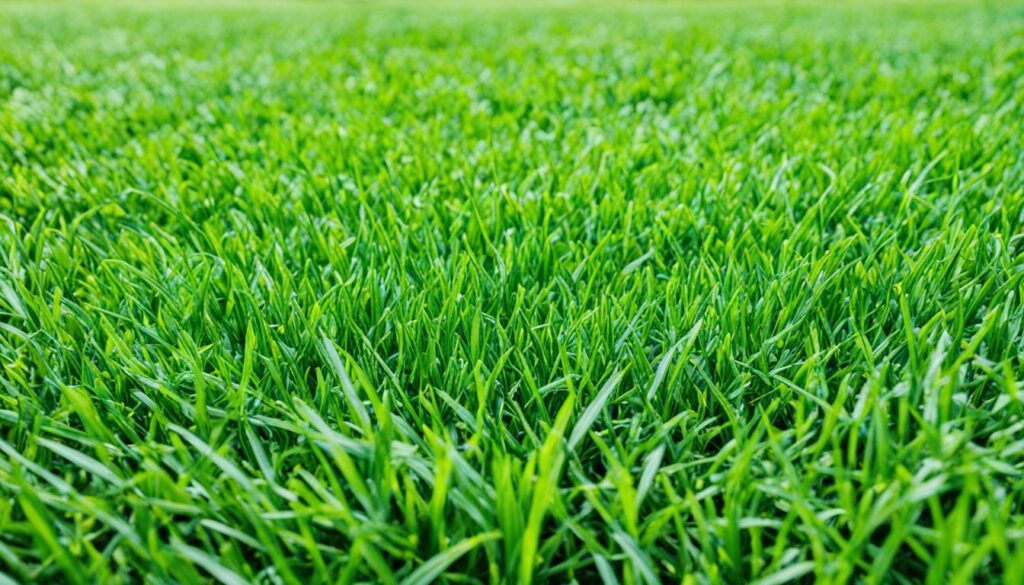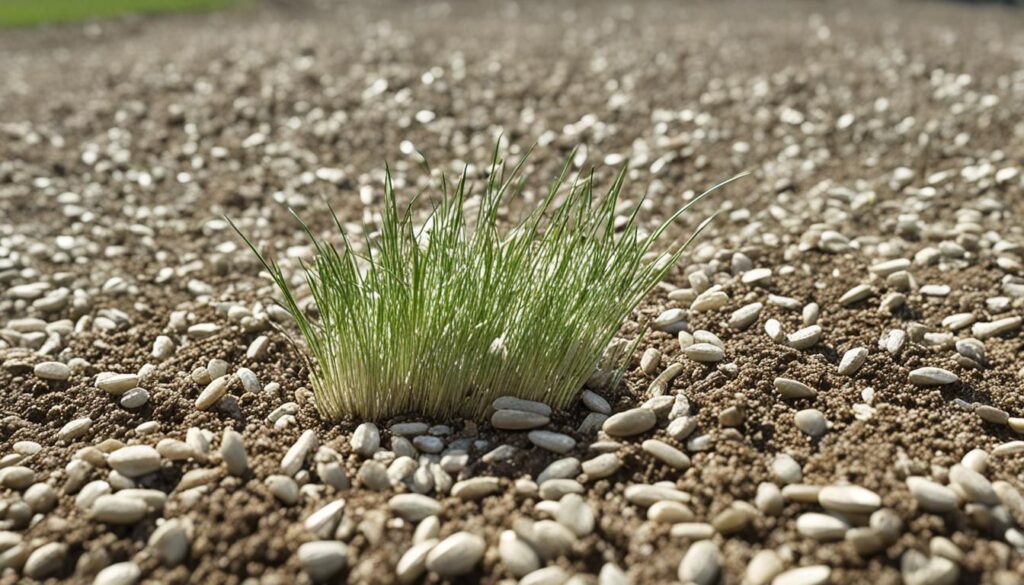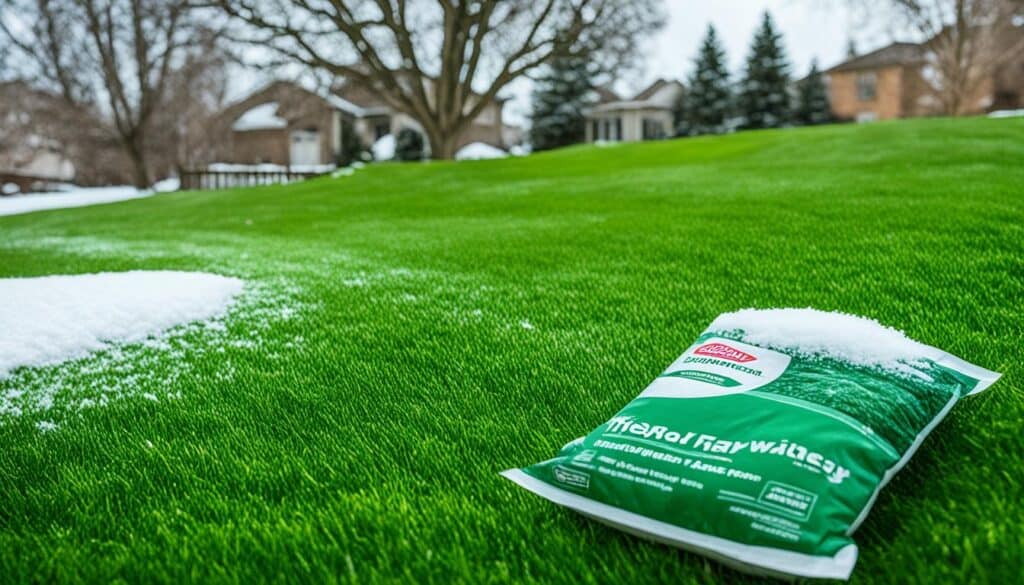Did you know 75% of homeowners struggle with knowing when to repair their lawns? The last five weeks of summer to early autumn are the best time for lawn rejuvenation. This period has the perfect conditions for grass seed germination, leading to a lush, green yard. Knowing when to repair your lawn with seed is key for a healthy and beautiful lawn.
Timing is everything in lawn care. Late summer and early fall have cooler temperatures and more dew, ideal for seed establishment. There’s also less weed competition, giving your new grass a better chance to grow. By repairing your lawn at the right time, you’re helping it stay strong through the seasons.
Your fall lawn care should focus on overseeding and fertilizing. This takes advantage of the best conditions and helps your lawn bounce back from summer stress. Seeding at the right time means you’re not just filling gaps; you’re making your lawn healthier and more beautiful for the long term.
Key Takeaways
- Late summer to early fall is the optimal window for lawn repair with seed
- Cool temperatures and increased dew create ideal conditions for seed germination
- Reduced weed competition in fall benefits new grass establishment
- Overseeding and fertilizing in fall are crucial components of lawn care
- Proper timing can significantly improve the success of your lawn repair efforts
Understanding Lawn Repair Basics
Lawn repair is key to keeping your yard healthy and green. It fixes damaged spots while keeping your lawn strong. Let’s explore the basics of lawn repair and why timing is important.
What Constitutes Lawn Repair
Lawn repair means fixing damaged areas. This includes filling bare spots, leveling the ground, and fixing lawn edges. Using grass seed is a common method, which takes a few months to work.
For the best results, spread 15-25g of grass seed per square meter. This helps new grass grow well.
Common Causes of Lawn Damage
Many things can harm your lawn:
- Pests and fungal diseases
- Inadequate sunlight or water
- Salt buildup
- Pet urine
- Too much foot traffic
- Fertilizer mistakes
- Compacted soil
Grass diseases like snow mold happen when it’s cold. It’s important to spot these problems early.
Importance of Timely Repairs
Fixing your lawn on time keeps it looking great. Spring or autumn are the best times for repairs. The soil is warm enough for new grass to grow.
For autumn lawn care, use fertilizers high in nitrogen. Fertilize your lawn three to four times a year. Do this in spring, early summer, late summer, and autumn.
| Repair Activity | Recommendation |
|---|---|
| Grass seed germination temperature | No higher than 15°C (60°F) |
| Depth to lift damaged turf | About 5cm (2in) |
| Wait time before walking on new grass | At least two weeks after sowing |
| Minimum grass height before first mowing | 10cm |
Using the right lawn care tools and materials is crucial. You’ll need a scarifier or rake, spreader, sprinkler, lawnmower, edge trimmer, grass seed, fertilizer, and lawn lime for acidic soils.
Best Time to Repair Lawn with Seed
Knowing when to repair your lawn with seed is key for growth. The best time depends on where you live and the grass type.
Late summer to early fall: Optimal seeding window
In northern areas, late summer to early fall is best for seeding cool-season grasses. The weather is cooler, and it rains more, making it great for seeds to grow. This is also when to use the best lawn fertilizer ratio for fall to help new growth.
Early spring: Second-best option
Spring can work well for fixing your lawn, especially after winter damage. But, spring seeding needs extra care. Traditional fertilizers might slow down seed growth. So, choose slow-release fertilizers for fall that won’t stop seeds from germinating.
Factors influencing seeding success
Many things affect how well your lawn repair works:
- Soil temperature
- Moisture levels
- Weed competition
- Grass type (cool-season vs. warm-season)

For warm-season grasses in southern areas, late spring to early summer is best. Just throwing grass seed on bare spots doesn’t usually work well. You need to prepare the soil right and take good care of it.
| Season | Cool-Season Grasses | Warm-Season Grasses |
|---|---|---|
| Spring | Second-best option | Ideal time |
| Summer | Not recommended | Good for established lawns |
| Fall | Optimal time | Not recommended |
| Winter | Plan for spring | Dormant seeding possible |
By knowing these factors and when to repair your lawn, you can get a lush, healthy lawn. Use the optimal NPK ratio for fall lawns if you’re seeding then.
Cool-Season vs. Warm-Season Grass Repair Timelines
Knowing when to repair your lawn depends on the grass type. Cool-season and warm-season grasses grow differently and have the best repair times.
Cool-season grasses like Kentucky bluegrass and tall fescue do well in late summer to early fall. They grow best when soil temperatures are 50-60°F and air temperatures are 60-75°F. For these lawns, it’s best to seed about 45 days before the first fall frost.
Warm-season grasses such as Bermuda and Zoysia are best repaired in late spring to early summer. They need soil temperatures of 65-70°F and air temperatures around 80°F. In California, seeding these lawns is ideal from mid-April to mid-May.
For fall lawns, phosphorus is key for cool-season grass repairs. It helps build strong roots. For warm-season grasses, a potassium boost in the winter prepares them for the cold months.
| Grass Type | Best Repair Time | Soil Temperature | Germination Time |
|---|---|---|---|
| Cool-Season | Late Summer/Early Fall | 50-60°F | 1-3 weeks |
| Warm-Season | Late Spring/Early Summer | 65-70°F | 3+ weeks |
Soil pH is important for grass health. Aim for a pH of 6.5 to 7 for the best seed growth. Adjust your lawn care to your grass type and local climate for great results.
Preparing Your Lawn for Seeding
Getting your lawn ready for seeding is key in your fall lawn care plan. Doing it right sets the stage for grass seed to grow well and create a lush lawn.
Soil Testing and Amendment
First, test your soil’s pH and nutrient levels. Aim for a pH between 6.0 and 7.0 for the best grass growth. Then, add nitrogen-rich fertilizers for fall if needed. Don’t forget, phosphorus is crucial for root growth in fall lawns.
Removing Debris and Dead Grass
Clear your lawn of debris, dead grass, and weeds. This is vital for new seed growth. Use a rake or power rake to clear away thatch, letting seeds reach the soil easily.
Loosening and Leveling the Soil
Loosen the top 6 to 8 inches of soil with a tiller or fork. This helps improve soil aeration and lets roots grow deeper. Level the area with a rake for even seed distribution.

| Grass Type | Best Seeding Time | Germination Period |
|---|---|---|
| Cool-Season Grasses | Late August to mid-October | 5 days to 3 weeks |
| Warm-Season Grasses | Late spring to early summer | Over a month |
Follow these steps and seed at the right time for a beautiful, thriving lawn. Keep the soil moist and avoid heavy foot traffic during the seedlings’ early growth.
Choosing the Right Grass Seed for Repairs
Finding the right grass seed is crucial for a lush, healthy lawn. Your choice should match your climate, sun exposure, and how much traffic it gets. Let’s look at some popular grass types and where they grow best.
For cool-season grass, think about a mix of Kentucky bluegrass, perennial ryegrass, and fescues. These grasses do well in moderate summers and in the cool seasons of spring and fall. Kentucky bluegrass likes 4 to 8 hours of sun a day and should be cut to 2 to 2-1/2 inches tall.
In warmer areas, consider Bermuda, Zoysia, or St. Augustine grass seeds. Bermudagrass is great for hot weather, drought, and lots of foot traffic in full sun. St. Augustine grass stays green into the fall, perfect for warm places with sandy soil.
| Grass Type | Climate | Characteristics |
|---|---|---|
| Kentucky Bluegrass | Cool-season | Medium drought tolerance, 4-8 hours sun |
| Perennial Ryegrass | Cool-season | High traffic tolerance, quick establishment |
| Tall Fescue | Cool-season | Drought-tolerant, low maintenance |
| Bermudagrass | Warm-season | Heat and drought-resistant, full sun |
| Zoysia | Warm-season | Heat-tolerant, dense growth, good drainage |
The best NPK ratio for fall lawns changes with the grass type and soil. Getting your soil ready is key for successful seed germination and growth. Pick high-quality seed mixes for better lawn repair results and a beautiful yard.
Step-by-Step Guide to Seeding Bare Patches
Fixing bare spots in your lawn can be fulfilling, especially when you add overseeding and fertilizing in fall. This guide will show you how to get a lush, healthy lawn.
Spreading the Seed
Begin by spreading grass seed evenly over bare areas. Use a rotary spreader or your hand for small spots. Make sure to follow the recommended seeding rate for full coverage.
After spreading, rake the seeds into the soil. This helps the seeds make good contact with the soil, which is key for germination. New grass usually starts to grow in about 10 days.
Covering and Protecting New Seeds
To keep your seeds safe, put a thin layer of mulch straw or topsoil over them. This cover keeps moisture in and keeps birds away. For more protection, use reflective tape or pinwheels on stakes.
These methods keep birds away without hurting them. It takes four to six months for seeded areas to blend with your lawn.
Proper Watering Techniques
Watering is key for seed germination and growth. Keep the soil’s top 2 inches moist. Water 2-4 times a day with a fine nozzle to prevent seeds from being washed away.
As the grass grows, start watering less often. Using slow-release fertilizers in fall can help with growth. With the right care, your seeded areas will quickly become a lush, healthy lawn.
FAQ
What is the best time to repair my lawn with seed?
The best time to repair your lawn with seed is in late summer to early autumn. This is when the weather cools down, and there’s more dew. It’s also when weeds grow less.
What constitutes lawn repair?
Lawn repair means fixing damaged spots while the rest of the lawn is still healthy. Damage can come from pests, diseases, shade, poor watering, salt, pet urine, too much foot traffic, fertilizer mistakes, and compacted soil.
What factors influence seeding success?
Seeding success depends on soil temperature, moisture, and weeds.
When is the best time to repair cool-season and warm-season grasses?
For cool-season grasses like ryegrass and Kentucky bluegrass, repair in late summer to early fall. Early spring is also good. Warm-season grasses like Bermuda and Zoysia do best in late spring to early summer.
How should I prepare my lawn for seeding?
Start with soil testing to check pH and nutrients. Then, clean the area of debris, dead grass, and weeds. Use a rake or aerator to loosen the soil if it’s hard. Level the soil and add compost and starter fertilizer to make it better for seeds.
How do I choose the right grass seed for repairs?
Pick grass seed that looks like your lawn and fits your climate and lawn needs. Think about how much sun it gets, how much traffic it will have, and if it can handle drought.
How do I properly seed bare patches?
Spread the seed evenly by hand or with a spreader, following the package’s advice. Gently rake the seeds into the soil for better contact. Cover with mulch straw or topsoil to keep seeds safe and moist.
Water the area well, keeping the soil moist. Water 2-4 times a day with a fine nozzle to keep seeds in place.




I don’t think the title of your article matches the content lol. Just kidding, mainly because I had some doubts after reading the article.
Thanks for reading the article and sharing your thoughts .
This Article helps the reader to Repair and Maintain their lawn . Thanks